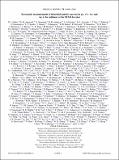Systematic measurements of identified particle spectra in pp, d+Au, and Au+Au collisions at the STAR detector
Author(s)
Sakuma, Tai; Miller, M. L.; Millane, Julie M.; Kocoloski, Adam Philip; Balewski, Jan T.; Surrow, Bernd; Hoffman, Alan Michael; ... Show more Show less
DownloadAbelev-2009-Systematic measureme.pdf (2.589Mb)
PUBLISHER_POLICY
Publisher Policy
Article is made available in accordance with the publisher's policy and may be subject to US copyright law. Please refer to the publisher's site for terms of use.
Terms of use
Metadata
Show full item recordAbstract
Identified charged-particle spectra of π[superscript ±], K[superscript ±], p, and p̅ at midrapidity (|y|<0.1) measured by the dE/dx method in the STAR (solenoidal tracker at the BNL Relativistic Heavy Ion Collider) time projection chamber are reported for pp and d+Au collisions at √[s[subscript NN]]=200 GeV and for Au+Au collisions at 62.4, 130, and 200 GeV. Average transverse momenta, total particle production, particle yield ratios, strangeness, and baryon production rates are investigated as a function of the collision system and centrality. The transverse momentum spectra are found to be flatter for heavy particles than for light particles in all collision systems; the effect is more prominent for more central collisions. The extracted average transverse momentum of each particle species follows a trend determined by the total charged-particle multiplicity density. The Bjorken energy density estimate is at least several GeV/fm[superscript 3] for a formation time less than 1 fm/c. A significantly larger net-baryon density and a stronger increase of the net-baryon density with centrality are found in Au+Au collisions at 62.4 GeV than at the two higher energies. Antibaryon production relative to total particle multiplicity is found to be constant over centrality, but increases with the collision energy. Strangeness production relative to total particle multiplicity is similar at the three measured RHIC energies. Relative strangeness production increases quickly with centrality in peripheral Au+Au collisions, to a value about 50% above the pp value, and remains rather constant in more central collisions. Bulk freeze-out properties are extracted from thermal equilibrium model and hydrodynamics-motivated blast-wave model fits to the data. Resonance decays are found to have little effect on the extracted kinetic freeze-out parameters because of the transverse momentum range of our measurements. The extracted chemical freeze-out temperature is constant, independent of collision system or centrality; its value is close to the predicted phase-transition temperature, suggesting that chemical freeze-out happens in the vicinity of hadronization and the chemical freeze-out temperature is universal despite the vastly different initial conditions in the collision systems. The extracted kinetic freeze-out temperature, while similar to the chemical freeze-out temperature in pp, d+Au, and peripheral Au+Au collisions, drops significantly with centrality in Au+Au collisions, whereas the extracted transverse radial flow velocity increases rapidly with centrality. There appears to be a prolonged period of particle elastic scatterings from chemical to kinetic freeze-out in central Au+Au collisions. The bulk properties extracted at chemical and kinetic freeze-out are observed to evolve smoothly over the measured energy range, collision systems, and collision centralities.
Date issued
2009-03Department
Lincoln Laboratory; Massachusetts Institute of Technology. Department of Physics; Massachusetts Institute of Technology. Laboratory for Nuclear ScienceJournal
Physical Review C
Publisher
American Physical Society
Citation
STAR Collaboration et al. “Systematic measurements of identified particle spectra in pp, d+Au, and Au+Au collisions at the STAR detector.” Physical Review C 79.3 (2009): 034909. © 2009 The American Physical Society
Version: Final published version
ISSN
0556-2813